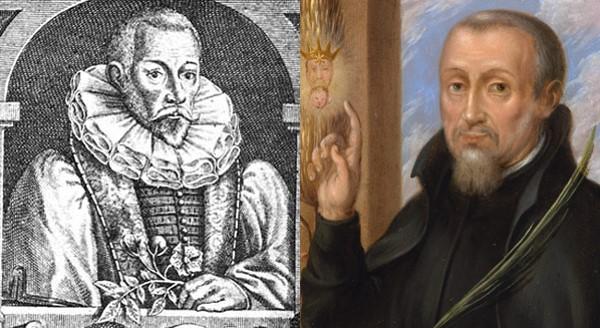More than 400 years’ worth of rumours about Jesuit involvement in the Gunpowder Plot are laid to rest as Dermot Preston SJ tells Fr John Gerard and Fr Henry Garnet’s stories, which were misrepresented in the BBC’s Gunpowder series.
By the time she died in 1603, Queen Elizabeth’s succession had been planned carefully by Robert Cecil and the Queen’s Council. As Elizabeth had no heir and many remembered the years of confusion over the succession after Henry VIII’s death, Cecil was convinced that stability was best achieved by paving the way for King James VI of Scotland, a great-grandson of Henry’s sister, Margaret, to succeed to the English throne. On Cecil’s secret advice, James VI cultivated the elderly Elizabeth who was quite charmed by the young monarch’s letters.
On Elizabeth’s death, Cecil and the Council pre-empted the various blood claims and immediately proclaimed James VI of Scotland, King James I of England.
James was the son of Mary Queen of Scots, whom many felt had died a martyr when she was executed in 1587 for allegedly plotting the death of Queen Elizabeth. Although James was brought up in the Protestant tradition after Mary had fled Scotland for sanctuary in England, many Catholics felt that James would be sympathetic to the religion of his mother and so they hoped that James’s accession to the throne in England would lead to a religious tolerance of Catholics. Indeed James himself had fostered these hopes when he made positive noises to certain Catholic noblemen who had sounded him out in the years before Elizabeth’s death.
It was not to be.
Almost as soon as King James came to power in London, he began to ratchet up anti-Catholic legislation and, with a parliamentary system becoming more dominated by the Puritan faction within the Church of England, the hopes of a toleration of Catholicism were quickly dashed and broken.
It was the despair provoked by this false dawn that led a group of Catholic nobles, led by Robert Catesby, to plan for a radical solution. Their plan was simple: to blow up Parliament in Westminster on the day when the King would be present to pass further anti-Catholic legislation. It was, they realised, a desperate throw of the dice which would lead to great loss of life, but in the vacuum of power that would be caused, they would take one of James’s children and proclaim them the new monarch who would – in due course – usher in a renewal of Catholic England.
The initial group of plotters numbered only five but as the plot became more complicated, extra people – mostly minor nobles – were drawn in and sworn to secrecy.
The Catholic community across England at that time was small and tended to be focused on a network of Catholic families up and down the country who had the power of influence and the financial clout to keep a Catholic micro-climate in a particular shire. These families took great risks as sheltering a priest was a treasonable offence and betrayal by a disgruntled employee or blackmailed relative was a real risk.
It seems clear that the Catesby plotters kept the secret of the plan quite tightly – perhaps only fifteen to twenty people were part of the inner circle in the end – but as they worked out details of what was to be done, as well as coming to terms with the logistical complexities, they realised that their plan was morally complicated. For example, what of the innocent people in the Parliament buildings who would be killed? Should they, for example, warn the Catholic Lords not to attend Parliament? Can an evil action bear good fruit?
All of the plotters were practising Catholics and they knew that their actions, for good and evil, would be part of their account to God when they died. They did not want their souls to be damned for eternity because of the Powder Treason.
Thus some of the plotters began to seek advice, and it was to the priests who were schooled in such practical ethics that they turned.
The network of priests in England was different to the present day: England was a dangerous mission territory, not unlike Stalin’s Russia. There were no bishops, and command-and-control was fluid; this lack of infrastructure had contributed to the failure of the mission of Edmund Campion in 1580/81. For a number of years, priests re-entering England after being trained abroad were vulnerable and isolated on arrival and were arrested quickly, either because of the spy network in continental ports or because something as simple as the cut and design of a cloak which was obviously not made in England might mark you out on the streets of London.
When the Jesuits Henry Garnet and Robert Southwell re-entered Britain in 1589, part of their task was to establish an infrastructure of safe-houses, clothing, transport and co-ordinated ministry which would allow the priests (secular and religious) to be absorbed into the network of Catholic town- and country-houses which were being adapted across England. Southwell, having taught many of the seminarians at the English College in Rome, found that by just roaming up and down the London docks he could recognise some of his ex-students who might have just landed and usher them to a place of safety and into the Catholic network.
By 1603 the network was established and although the Elizabethan cat had developed into a sophisticated hunter, the Catholic mouse had developed a robust security system. The game was life and death, but it was being played by brave priests and lay people who valued their faith.
The false dawn of James’s accession broke the spirit of a number of the community who could now see no light at the end of the tunnel. Patience was being demanded, but to what end?
The approach of the plotters to the priests was somewhat roundabout and originally didn’t trigger the radar of the priests in question. Henry Garnet recalled Catesby once holding him in discussion on the theoretical merits and demerits of ‘just war’ theory. It was only later that Garnet heard through the grapevine that tumults were afoot, that he suspected that something was amiss.
When this became clear, Garnet, in the hope of foreclosing any action, urgently contacted the Jesuit General in Rome to get the pope to issue a general letter forbidding Catholics from plotting or taking up arms against secular rulers.
For Garnet, the extent of the plan was confirmed when one of his fellow Jesuit priests, Fr Oswald Tesimond, came to confession and opened up to Garnet that a plot was taking shape. Tesimond himself had been told in confession by Catesby that they were planning a commotion. Tesimond, as a young priest, realised that he was getting into deep waters and asked Catesby whether he could take counsel from the older Fr Garnet who was head of the Jesuit mission and ipso facto leader of the recusant priests. Catesby agreed that the secrecy of his confession could be opened to Garnet. For his part, Tesimond indicated to Garnet that he was free to break the seal of Tesimond’s confession if he was ever threatened with torture.
It has been much debated how much the government knew of the Gunpowder Plot. The standard story is that it was a routine search of the basement of parliament that found Guy Fawkes, one of the plotters, guarding the 36 barrels of gunpowder. At the other extreme, there are some that hold that the scheme was a government plot from start to finish and was carefully cultivated as a ‘sting’ to draw in potentially violent plotters from the Catholic community. Others believe that the truth lies somewhere in the middle – the government got wind of an embryonic plot and nurtured it to their advantage.
Whatever was the origin, the capture of Fawkes and the discovery of the gunpowder led to a breakdown of the plan. Catesby fled to the Midlands with the key plotters and decided to fight to the end. He and others were killed in the siege which was the climax of the action, and the surviving plotters were taken back to London and were imprisoned, tortured for information, tried and eventually executed. Despite being nobles, for whom a capital sentence would normally be carried out by beheading, all the plotters were executed by hanging, drawing and quartering as a sign of their treason.
Whatever the source of the Gunpowder Plot itself, the government now realised that the aftermath had handed them a unique opportunity to break the back of the recusant Catholic community which had been a constant irritant during the Elizabethan period, and the plan against the Jesuits began to be steered accordingly.
In the 16th century, as well as orchestrating the more brutal direct measures of fining and punishment for recusants, the Queen’s secret service, led by Sir Francis Walsingham, had long been trying to divide and conquer the Catholic community from within by sowing seeds of division using human suspicions, natural biases, money and carefully cultivated agent provocateurs. Discontent was most fraught among the clergy with one particular bone of contention: in the absence of any bishops on the ground in England, just who was in charge?
A number of clergy resented the fact because the Jesuit mission superior had a natural network of colleagues, he was the leader. Garnet was conscious of the delicacy of his role and he was one of the people to push Rome for the appointment of an archpriest, Fr Blackwell, as a leader of the secular clergy. But even after this appointment, divisions remained among some of the clergy. For some it was genuine question, but for some, sadly, they were in the pay of the government. This issue had been simmering since the early 1590s.
In the early days after the discovery of the plot, when the vast majority of Catholics were distraught to hear of it, the government began to articulate the careful narrative that they realised that only certain Catholics were responsible for the plot. The King, they said, was wise and lenient, and recognised the innocence of many, but the plot had been the work of certain Catholics and they knew for a fact that the Jesuits were their spiritual leaders and, indeed, had instigated the plot. Thus a permanent wedge of suspicion could be driven between the Jesuits and the rest of the clergy.
Tabloid mob-politics is not limited to the history of the Daily Mail, so soon the cry went out across the land for the arrest of Fr Henry Garnet, Fr John Gerard and their perfidious colleagues, and government officials clicked into gear to demonstrate their loyalty to the crown which had been threatened.
Gerard, a charismatic and engaging figure, originally from near Wigan in Lancashire, was famous in the land as he was one of the few people who ever escaped from the Tower of London; he did this in 1597 after three years of imprisonment and torture. He only evaded execution because of the public backlash that had come to the government from the execution of Fr Robert Southwell in 1595. After his escape, Gerard returned with enthusiasm to missionary work up and down Britain but he was a marked man, and one whom the government would have loved to re-capture after the embarrassment of his escape.
Life for Garnet and Gerard now became very precarious. Although many who knew Garnet knew the accusations against him were false, to hide him and his colleagues was nonetheless perilous, but some still responded with generosity. Eventually Garnet took shelter in Hindlip Hall, just outside of Worcester. Gerard headed south.
Betrayal came quickly for Garnet and Hindlip was named as the house where he might be hiding. The priest-hunters arrived unexpectedly and in force. Hindlip had been adapted with sophisticated hiding places, but because of the speed of the invasion of the premises, the Jesuits were hidden awkwardly with little space (because of stored furniture) and no provisions for eating and drinking. The hunters set in for a long exploration and they were unsuccessful for a week. In the dead of night, two Jesuit brothers, Nicholas Owen and Ralph Ashley decided to leave their hiding place – they had had nothing but a single apple to eat for seven days – either to blend into the household, or (if they were taken) to throw the scent of the hunters who might feel that they had caught their prey. Garnet and Edward Oldcorne, both priests, remained in hiding and they decided they would die rather than give their own position away and endanger the household. After a second week of searching their hide was discovered.
Garnet was transferred to London and thence to the Tower, and in the weeks to come was questioned and interrogated under torture before eventually being brought to trial. Oldcorne, Ashley and Owen were tortured for information, and Owen died under torture. Oldcorne and Ashley were returned for execution to Worcester where they were hanged, drawn and quartered. Garnet remained an isolated figure alone in the Tower and all those who could speak for him were now dead.
To understand the context of Garnet’s ‘show-trial’ in 1606, it would be important to step back to 1586 when, just a few weeks after the arrival of Garnet and Southwell in England, their superior Fr William Weston was arrested and put on trial. That trial was seen by the authorities as an opportunity to darken the name of Weston and the Jesuits, but Weston’s reputation was one of such holiness that the charge never got traction with the public and so Weston was imprisoned for life, but not executed. He was exiled to Europe in 1603.
By the time of Garnet’s trial at the Guildhall in 1606, some of those who were involved in the prosecution of Weston had now risen to great power in the legal structures of the land. Edward Coke, Attorney General, was one of those and now that the times had changed, the prosecution of Henry Garnet offered a golden opportunity to complete the task which had been to hand a generation before.
Despite being severely weakened by the torture and the conditions, Garnet defended himself well, with no resources but his memory and native wit; but the tide was now against him. Owing to his compromised interface with the plotters, the complexity of the web being woven and the fact that the niceties of the seal of confession were somewhat distant to the Anglican practice of the people, Garnet was found guilty as charged and was executed for treason at St Paul’s Churchyard in early May 1606. The proverbial scheming Jesuit was etched into the English culture and language.
John Gerard was still on the run. He was helped by the Catholic community to make his way to the coast in a final attempt to escape Britain – his target was the entourage of the Spanish ambassador, who was returning to continental Europe.
For the morning he was constantly being rebuffed by officials who feared that the ambassador would be compromised should Gerard be recognised. All looked futile, until suddenly a change was ordered and Gerard, disguised as a footman, set sail from England’s shores. Weeks later, when he read of the death of Garnet, Gerard realised that the change of heart of the ambassador took place at exactly the same moment that Garnet had been executed; and Gerard always believed that it was Garnet’s arrival in heaven that prompted the change of heart and his escape.
Given that he was the only surviving Jesuit with an inner knowledge of ‘the Powder Treason’, on instruction of the Jesuit General, Gerard wrote both his autobiography and a narrative of the Gunpowder Plot. He died peacefully in Rome in 1637.
Oldcorne and Ashley were pronounced ‘Blessed’ by the Church in 1927. In 1970, Robert Southwell and Nicholas Owen were canonised as two of the ten Jesuits among the Forty Martyrs of England and Wales. Henry’s nephew, Fr Thomas Garnet, is also in that select number: he was martyred at Tyburn in 1607.
Dermot Preston SJ is team leader of the St Henry Morse mission in Newcastle-upon-Tyne.
This article was originally published on the website of the Jesuits in Britain.






